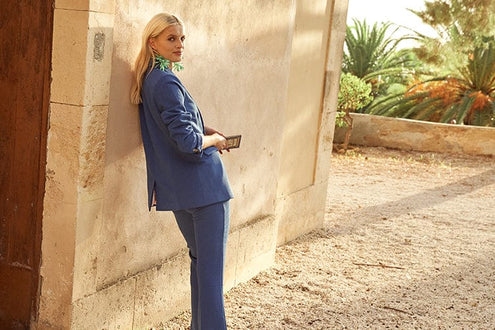
MISSION STATEMENT
At POM Amsterdam we have adapted our mission. We don't just want to empower women with colorful fashion, but with colorful and sustainable fashion. Why? Because we want to make people happy with our fashion, but also realize that the production process has a negative impact on our planet. That is why we want to do our best to minimize that negative impact.
Let's be open and honest: at the moment POM Amsterdam is not yet as sustainable as we would like. Making clothes in a sustainable way is a huge challenge. Making a new dress requires a lot of energy, raw materials and water.
In addition, making clothing causes CO2 emissions and the production process has an impact on human and animal welfare. With a more sustainable POM Amsterdam, we therefore not only think of nature, but we also check whether the production process takes place under the right working conditions.
TOWARDS A
MORE SUSTAINABLE
POM AMSTERDAM

MISSION STATEMENT
ECO & ANIMAL FRIENDLY MATERIALS
CO2- NEUTRAL IN 2030
We express our intention to reduce our CO2 emissions step by step and to be a CO2 neutral company by 2030. We want to achieve this, among other things, by using as many eco-friendly materials as possible in our collections, packaging our products in responsible packaging and finally, we want to produce more locally and cooperate with transport partners who can transport our items in a more sustainable way. Unfortunately, CO2 emissions cannot be completely avoided, so we will calculate and compensate the remaining emissions annually.
CERTIFIED PRODUCTION COMPANIES
ECO MATERIALS

ORIGIN AND TRANSPORT
At POM Amsterdam we have adapted our mission. We don't just want to empower women with colorful fashion, but with colorful and sustainable fashion. Why? Because we want to make people happy with our fashion, but also realize that the production process has a negative impact on our planet. That is why we want to do our best to minimize that negative impact.
In addition, making clothing causes CO2 emissions and the production process has an impact on human and animal welfare. With a more sustainable POM Amsterdam, we therefore not only think of nature, but we also check whether the production process takes place under the right working conditions.
ECO & ANIMAL FRIENDLY MATERIALS
CERTIFIED PRODUCTION COMPANIES
CO2-NEUTRAL IN 2030
ECO MATERIALS
ORIGIN AND TRANSPORT
“POM WILL BECOME MORE SUSTAINABLE, WITH THE ULTIMATE GOAL OF BEING CO2 NEUTRAL BY 2030.”
‘‘POM WILL BECOME MORE SUSTAINABLE, WITH THE ULTIMATE GOAL OF BEING CO2 NEUTRAL BY 2030.’’



